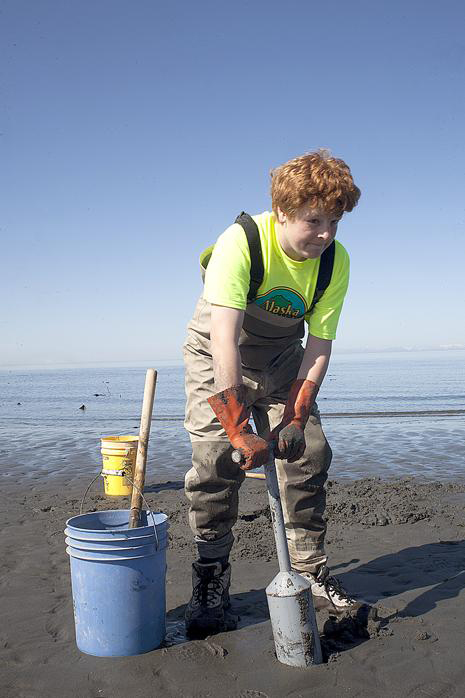The razor clam sport and personal use fisheries on the east side of the Cook Inlet will remain closed for a second year. The number of razor clams on beaches in Ninilchik and Clam Gulch are still too low to allow harvesting, according to Matt Miller, the Alaska Department of Fish & Game’s regional management coordinator for sportfishing in the Upper Cook Inlet. The department conducted surveys this year on five beaches on the peninsula — Ninilchik North and South, Clam Gulch North and South and the Oil Pad Access North.
The abundance of mature size razor clams remained at historical low levels on all five beaches, according to the report presented at the Board of Fisheries work session Thursday.
“They were still down to historic lows, so those are looking pretty bad,” Miller said. “The number at Ninilchik were also low, but the oil pad beaches showed a little more recruitment.”
Numbers have plummeted drastically for the mature razor clams in the past few decades. In 1999, Clam Gulch’s North beach had more than 4 million clams, and the south beach had more than 6.1 million. This year, the department counted 164,851 and 106,005 at the north and south beaches, respectively.
Researchers counted more than 6.5 million clams at the Oil Pad Access beach in 1999, which had fallen to 107,474 in 2015. Ninilchik North and South fell from 597,993 and 308,129 in 1998 to 33,535 and 69,934, respectively.
Juvenile razor clams similarly declined, though not as drastically. Miller said they hoped the numbers would recover when Fish & Game closed the fisheries earlier in 2015, but they have not begun to recover yet, he said.
When a board member asked if people still harvesting clams were damaging the numbers, Miller said the department was unaware of any people still harvesting illegally.
“Staff has posted signs out there and we’ve talked to law enforcement about that,” Miller said. “I’m not aware of any issues.”
The reason for the decline is still unknown, but so far, findings do not indicate that overharvesting is the problem, said Carol Kerkvliet, a sport fisheries biologist based in Homer. The decline began in the early 2000s, and as the numbers decreased, so did effort, she said.
Fish & Game closed the beaches in Ninilchik in 2014 and again in 2015, but during that time still saw a 58 percent natural mortality, she said. In combination with low spawning success and poor settling success of the juvenile clams, the cause many be any one of a number of factors, she said.
“The mature size clams are not living as long either,” Kerkvliet said. “These all fit together in that it suggests low spawning success, or settling success of the larvae before they settle onto the beach. Then also the poor survival of the larger size clams suggests some sort of environmental impact, and it could be a combination of many things.”
The board’s discussed the clam numbers at the Statewide Dungeness Crab, Shrimp and Miscellaneous Shellfish meeting held in March 2015, debating whether to restrict harvesting by regulation. The board instead chose to continue using emergency orders to restrict the fishery as long as the department continued to monitor the numbers.
Board member Bob Mumford raised a concern about shifting clam harvesters from the east side of the inlet to the west side, potentially damaging the clam populations there.
“It sounds like we’ve transplanted a lot of clammers from the east side to the west side now,” Mumford said. “Is the department looking at the west side now? Are we threatening the clams on that side?”
Miller said Fish & Game was watching for that effect but has yet to see a negative impact on the west side fisheries. Possibly because the beaches on the west side of the inlet are so much more remote, fewer clammers chose to go there, he said.
“Because those beaches are so remote, we weren’t expecting a big balloon over there, and so far, we haven’t seen that,” Miller said. “We won’t actually have an estimate done until we get the statewide harvest surveys done, but the preliminary result was that we haven’t seen a significant decrease.”
Fish & Game will issue the emergency order at the beginning of the year, after the current order expires in December, Miller said.
Reach Elizabeth Earl at elizabeth.earl@peninsulaclarion.com.

